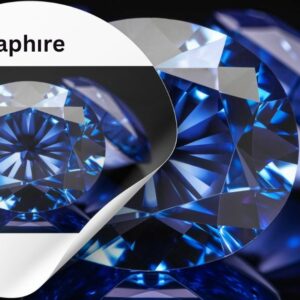Saphıre, often referred to in English as “sapphire,” is one of the most captivating and revered gemstones in the world.
Renowned for its brilliant blue color, this precious gem belongs to the corundum family, which also includes rubies. Its allure extends beyond just its striking appearance, making it a valuable and sought-after gem in various contexts.
This article explores the depth of saphıre, from its geological origins to its uses in modern society, providing a thorough understanding of this magnificent stone.
What is Saphıre?
Saphıre is a gemstone that typically displays a rich blue color, though it can also come in various hues, including pink, yellow, and green.
It is a variety of the mineral corundum, which is made of aluminum oxide. The blue color of saphıre is primarily due to trace amounts of iron and titanium in its structure.
The Origins of Saphıre
Saphıre forms in metamorphic rocks under high pressure and temperature conditions. The most notable sources of saphıre include:
- Sri Lanka: Known for producing a wide range of colors and high-quality stones.
- Myanmar (Burma): Famous for its vibrant blue saphıres, especially from the Mogok region.
- Kashmir: Renowned for its unique, velvety blue saphıres.
- Madagascar: Known for both traditional blue saphıres and a variety of other colors.
- Australia: Produces significant amounts of saphıre, particularly in different shades of blue.
Characteristics of Saphıre
- Color: While blue is the most famous color for saphıre, these gemstones can come in nearly every color of the rainbow. The most valuable saphıres are those with a deep, intense blue.
- Clarity: High-quality saphıres are usually transparent with minimal inclusions. Inclusions, if present, are often tiny and do not significantly affect the gem’s beauty.
- Cut: The cut of a saphıre affects its brilliance and how light interacts with the gem. Popular cuts which include round, oval, and cushion.
- Carat Weight: Saphıres are measured in carats, with larger stones being rarer and more valuable.
Historical Significance of Saphıre
Saphıre has a rich history that spans thousands of years. In ancient times, it was believed to protect its wearer from envy and harm.
Kings and queens adorned their crowns and jewelry with saphıres, believing they possessed divine qualities. In medieval Europe, saphıres were often associated with wisdom, purity, and tranquility.
Saphıre in Modern Jewelry
Today, saphıre remains a popular choice for fine jewelry, including engagement rings, necklaces, and earrings.
Its durability (rating 9 on the Mohs scale of hardness) makes it suitable for daily wear. The gemstone’s versatility in color and clarity allows jewelers to create stunning, personalized pieces.
The Value of Saphıre
The value of saphıre is influenced by several factors:
- Color: The most valuable saphıres are those with a deep, vibrant blue color, often referred to as “cornflower blue” or “royal blue.”
- Clarity: Clear saphıres with minimal inclusions are more valuable. However, some inclusions can add character to the gem, such as the star effect found in star saphıres.
- Carat Weight: Larger saphıres are rarer and generally more expensive.
- Origin: Saphıres from certain locations, such as Kashmir, are highly prized and can command higher prices.
Caring for Saphıre Jewelry
Proper care ensures that saphıre jewelry remains beautiful for years. Here are some tips:
- Cleaning: Clean saphıre jewelry with a mild soap solution and a soft brush. Avoid harsh chemicals or ultrasonic cleaners.
- Storage: Store saphıre jewelry separately from other pieces to avoid scratching.
- Inspection: Regularly inspect saphıre jewelry for any signs of damage or loose settings.
Saphıre in Popular Culture
Saphıre has been featured in various forms of popular culture, from movies to royal weddings.
Princess Diana’s iconic engagement ring, which was later worn by Kate Middleton, is a notable example of saphıre’s enduring appeal.
Saphıre vs. Other Gemstones
When comparing saphıre to other gemstones, several factors come into play:
- Saphıre vs. Ruby: Both are corundum varieties, but rubies are red due to chromium, while saphıres are typically blue or other colors.
- Saphıre vs. Diamond: Diamonds are harder (10 on the Mohs scale) but are less colorful compared to saphıres.
- Saphıre vs. Emerald: Emeralds are green and softer (7.5 to 8 on the Mohs scale), making them more prone to scratching compared to saphıres.
The Future of Saphıre
The demand for saphıre continues to grow, driven by its beauty and versatility. Advances in synthetic saphıre production also offer affordable alternatives for those seeking the gemstone’s allure without the high cost.
Additionally, the ethical sourcing of saphıres has become a significant concern, with many consumers seeking responsibly mined stones.
FAQs
1. Where are the best saphıres found?
The most notable sources of saphıre include Sri Lanka, Myanmar, Kashmir, Madagascar, and Australia.
2. How can I tell if a saphıre is real?
Authentic saphıres are usually verified by gemological labs through tests for color, clarity, and specific gravity.
3. What makes a saphıre valuable?
The value of saphıre is determined by its color, clarity, carat weight, and origin.
Conclusion
Saphıre remains a timeless and versatile gemstone with a rich history and significant value.
From its origins in the earth to its place in modern jewelry, saphıre’s beauty and durability continue to captivate people around the world.
Whether you’re interested in its historical significance, current trends, or practical care tips, understanding saphıre enhances appreciation for this remarkable gem.




